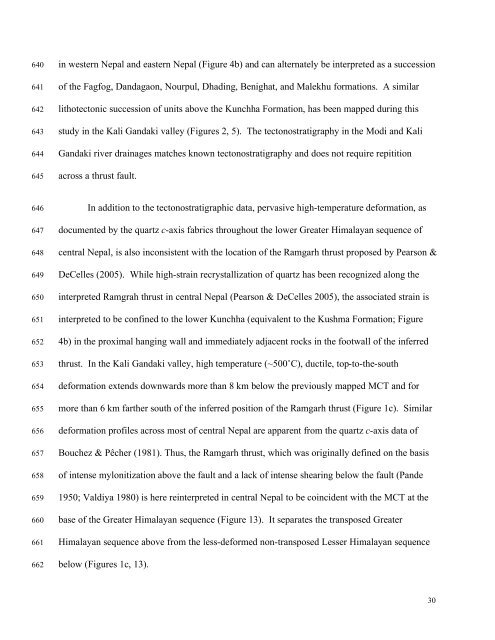Kinematics of the Greater Himalayan sequence, Dhaulagiri Himal ...
Kinematics of the Greater Himalayan sequence, Dhaulagiri Himal ...
Kinematics of the Greater Himalayan sequence, Dhaulagiri Himal ...
Create successful ePaper yourself
Turn your PDF publications into a flip-book with our unique Google optimized e-Paper software.
640<br />
641<br />
642<br />
643<br />
644<br />
645<br />
in western Nepal and eastern Nepal (Figure 4b) and can alternately be interpreted as a succession<br />
<strong>of</strong> <strong>the</strong> Fagfog, Dandagaon, Nourpul, Dhading, Benighat, and Malekhu formations. A similar<br />
lithotectonic succession <strong>of</strong> units above <strong>the</strong> Kunchha Formation, has been mapped during this<br />
study in <strong>the</strong> Kali Gandaki valley (Figures 2, 5). The tectonostratigraphy in <strong>the</strong> Modi and Kali<br />
Gandaki river drainages matches known tectonostratigraphy and does not require repitition<br />
across a thrust fault.<br />
646<br />
647<br />
648<br />
649<br />
650<br />
651<br />
652<br />
653<br />
654<br />
655<br />
656<br />
657<br />
658<br />
659<br />
660<br />
661<br />
662<br />
In addition to <strong>the</strong> tectonostratigraphic data, pervasive high-temperature deformation, as<br />
documented by <strong>the</strong> quartz c-axis fabrics throughout <strong>the</strong> lower <strong>Greater</strong> <strong><strong>Himal</strong>ayan</strong> <strong>sequence</strong> <strong>of</strong><br />
central Nepal, is also inconsistent with <strong>the</strong> location <strong>of</strong> <strong>the</strong> Ramgarh thrust proposed by Pearson &<br />
DeCelles (2005). While high-strain recrystallization <strong>of</strong> quartz has been recognized along <strong>the</strong><br />
interpreted Ramgrah thrust in central Nepal (Pearson & DeCelles 2005), <strong>the</strong> associated strain is<br />
interpreted to be confined to <strong>the</strong> lower Kunchha (equivalent to <strong>the</strong> Kushma Formation; Figure<br />
4b) in <strong>the</strong> proximal hanging wall and immediately adjacent rocks in <strong>the</strong> footwall <strong>of</strong> <strong>the</strong> inferred<br />
thrust. In <strong>the</strong> Kali Gandaki valley, high temperature (~500˚C), ductile, top-to-<strong>the</strong>-south<br />
deformation extends downwards more than 8 km below <strong>the</strong> previously mapped MCT and for<br />
more than 6 km far<strong>the</strong>r south <strong>of</strong> <strong>the</strong> inferred position <strong>of</strong> <strong>the</strong> Ramgarh thrust (Figure 1c). Similar<br />
deformation pr<strong>of</strong>iles across most <strong>of</strong> central Nepal are apparent from <strong>the</strong> quartz c-axis data <strong>of</strong><br />
Bouchez & Pêcher (1981). Thus, <strong>the</strong> Ramgarh thrust, which was originally defined on <strong>the</strong> basis<br />
<strong>of</strong> intense mylonitization above <strong>the</strong> fault and a lack <strong>of</strong> intense shearing below <strong>the</strong> fault (Pande<br />
1950; Valdiya 1980) is here reinterpreted in central Nepal to be coincident with <strong>the</strong> MCT at <strong>the</strong><br />
base <strong>of</strong> <strong>the</strong> <strong>Greater</strong> <strong><strong>Himal</strong>ayan</strong> <strong>sequence</strong> (Figure 13). It separates <strong>the</strong> transposed <strong>Greater</strong><br />
<strong><strong>Himal</strong>ayan</strong> <strong>sequence</strong> above from <strong>the</strong> less-deformed non-transposed Lesser <strong><strong>Himal</strong>ayan</strong> <strong>sequence</strong><br />
below (Figures 1c, 13).<br />
30

















